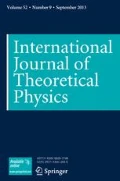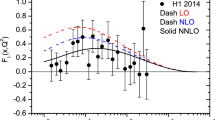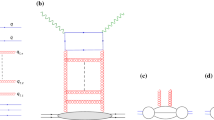Abstract
We present a set of formulas to extract the longitudinal proton structure function FL(x, Q2) and the reduced cross section σr(x, Q2) by using Dokshitzer–Gribov–Lipatov–Altarelli–Parisi (DGLAP) evolution equations and Altarelli-Martinelli equation at the leading order (LO) and the next-to-leading order (NLO) approximations in perturbative quantum chromodynamics (QCD). These formulas are obtained by the Laplace transform method at the virtualities higher than \({Q_{0}^{2}}\). We show that, the obtained equations for FL and σr depend only on the parton distribution functions (PDF’s) at the initial scale \({Q_{0}^{2}}\). We obtain the corresponding numerical results in a range of the virtuality \({Q_{0}^{2}}\leq Q^{2} \leq 800\) GeV2 and Bjorken scale 10− 4 ≤ x ≤ 1 and compare them with the results achieved by MSTW2008 (Martin et al. Eur. Phys. J 63(2), 189–285, 2009), WT (White and Thorne Phy. Rev. D 75(3), 034005, 2007) and Dipole (b-Sat) model (H. Kowalski, L. Motyka, G. Watt, Phys. Rev. D 74(7), 074016, 2006) predictions and also with data released by the Hadron Electron Ring Accelerator (HERA). Our numerical results show an acceptable agreement with the deep inelastic scattering (DIS) experimental data throughout over a wide range of the Bjorken scale x and the virtuality Q2, and then can be applied in analyses of the Large Hadron Collider and Future Circular Collider projects.











Similar content being viewed by others
Notes
Here and subsequently, the subscript (1) and (2) denote the LO and NLO approximations, respectively.
References
Glück, M., Reya, E., Vogt, A.: Dynamical parton distributions of the proton and small-x physics. Zeitschrift für Physik C Particles and Fields 67(3), 433–447 (1995)
Martin, A.D., Stirling, W.J., Thorne, R.S., Watt, G.: Parton distributions for the LHC. Eur. Phys. J. C 63(2), 189–285 (2009)
Khanpour, H., Mirjalili, A., Atashbar Tehrani, S.: Analytic derivation of the next-to-leading order proton structure function \({F_{2}^{p}} (x, Q^{2})\) based on the Laplace transformation. Phys. Rev. C 95(3), 035201 (2017)
Zarrin, S., Boroun, G.R.: Solution of QCD ⊗ QED coupled DGLAP equations at NLO. Nuclear Physics B 922, 126–147 (2017)
Martin, A.D.: Proton structure, Partons, QCD, DGLAP and beyond. arXiv:0802.0161 (2008)
Boroun, G.R., Zarrin, S., Teimoury, F.: Decoupling of the DGLAP evolution equations by Laplace method. The European Physical Journal Plus 130 (10), 1–6 (2015)
Navelet, H., Peschanski, R., Royon, C.h., Wallon, S.: Proton structure functions in the dipole picture of BFKL dynamics. Phys. Lett. B 385(1-4), 357–364 (1996)
Hentschinski, M., Sabio Vera, A., Salas, C.: F2 and FL at small x using a collinearly improved BFKL resummation. Phys. Rev. D 87(7), 07600 (2013)
Rezaei, B., Boroun, G.R.: Longitudinal structure function from the parton parameterization. The European Physical Journal A 56(10), 1–15 (2020). (ok)
Boroun, G.R.: Hard-pomeron behavior of the longitudinal structure function FL in the next-to-leading order at low x. Int. J. Mod. Phys. E 18, 131 (2009)
White, C.D., Thorne, R.S.: Global t to scattering data with next-to-leading logarithmic BFKL resummations. Phys. Rev. D 75(3), 034005 (2007)
Baruah, N., Sarma, J.K.: Evolutions of longitudinal structure function FL upto Next-to-Next-to-Leading orders at small-x. Int. J. Theor. Phys. 53(7), 2492–2504 (2014)
Kotikov, A.V., Parente, G.: The longitudinal structure function FL as a function of f2 and \(df_{2}/d \ln q^{2}\) at small x. The Next-to-Leading analysis. Modern Phys. Lett. A 12(13), 963–973 (1997)
Rezaei, B., Boroun, G.R.: Analytical solution of the longitudinal structure function FL in the leading and next-to-leading-order analysis at low x with respect to Laguerre polynomials method. Nucl. Phys. A 857(1), 42–47 (2011)
Kaptari, L.P., Kotikov, A.V., Chernikova, N.Yu., Zhang, P.: Longitudinal structure function fl at small x extracted from the Berger–Block–Tan parametrization of f2. JETP Lett. 109(5), 281–285 (2019)
Kaptari, L.P., Kotikov, A.V., Yu Chernikova, N., Zhang, P.: Extracting the longitudinal structure function FL(x, Q2) at small x from a Froissart-bounded parametrization of F2(x, Q2). Phys. Rev. D 99(9), 096019 (2019)
Block, M.M., Durand, L., Ha, P., McKay, D. W.: Applications of the leading-order Dokshitzer-Gribov-Lipatov-Altarelli-Parisi evolution equations to the combined HERA data on deep inelastic scattering. Phys. Rev. D 84(9), 094010 (2011)
Block, M.M., Durand, L., Ha, P.: Connection of the virtual γ∗ p cross section of e p deep inelastic scattering to real γ p scattering, and the implications for ν N and ep total cross sections. Phys. Rev. D 89(9), 094027 (2014)
Boroun, G.R.: Nonlinear correction to the longitudinal structure function at small x. The European Physical Journal A 43(3), 335–338 (2010)
Baruah, N., Das, M.K., Sarma, J.K.: Longitudinal structure function F L of proton from regge like behaviour of structure function at small-x. Few-Body Systems 55(11), 1061–1071 (2014)
Boroun, G.R.: Longitudinal structure function from logarithmic slopes of F 2 at low x. Phys. Rev. C 97(1), 015206 (2018)
Golec-Biernat, K., Staśto, A. M.: FL proton structure function from the unified DGLAP/BFKL approach. Phys. Rev. D 80(1), 014006 (2009)
Andreev, V., Baghdasaryan, A., Baghdasaryan, S., Begzsuren, K., Belousov, A., Belov, P., Boudry, V., et al.: Measurement of inclusive ep cross sections at high Q2 at \(\sqrt s= 225\) and 252GeV and of the longitudinal proton structure function fL at HERA. Eur. Phys. J. C 74(4), 2814 (2014)
Aaron, F.D., Abramowicz, H., Abt, I., Adamczyk, L., Adamus, M., Al-daya Martin, M., Alexa, C., et al.: Combined measurement and QCD analysis of the inclusive e±p scattering cross sections at HERA. Journal of High Energy Physics 2010(1), 109 (2010)
Abramowicz, H., Abt, I., Adamczyk, L., Adamus, M., Aggarwal, R., Antonelli, S., Arslan, O., et al.: Deep inelastic cross-section measurements at large y with the ZEUS detector at HERA. Phys. Rev. D 90(7), 072002 (2014)
Aaron, F.D., Alexa, C., Andreev, V., Antunovic, B., Aplin, S., Asmone, A., Astvatsatourov, A., et al.: Measurement of the proton structure function fL(x, q2) at Low x. Phys. Lett. B 665(4), 139–146 (2008)
White, C.D., Thorne, R.S.: Global fit to scattering data with next-to-leading logarithmic BFKL resummations. Phys. Rev. D 75(3), 034005 (2007)
Kowalski, H., Motyka, L., Watt, G.: Exclusive diffractive processes at HERA within the dipole picture. Phys. Rev. D 74(7), 074016 (2006)
Moch, S., Vermaseren, J.A., Vogt, A.: The longitudinal structure function at the third order. Phys. Lett. B 606(1-2), 123–129 (2005)
Dokshitzer, Y.L.: Calculation of the structure functions for deep inelastic scattering and e+e− annihilation by perturbation theory in quantum chromodynamics. Zh. Eksp. Teor. Fiz 73, 1216 (1977)
Altarelli, G., Parisi, G.: Asymptotic freedom in parton language. Nucl. Phys. B 126(2), 298–318 (1977). (23)
Gribov, V.N., Lipatov, L.N.: Deep Inelastic Ep-Scattering in a Perturbation Theory. Inst. of Nuclear Physics, Leningrad (1972)
Altarelli, G., Martinelli, G.: Transverse momentum of jets in electroproduction from quantum chromodynamics. Phys. Lett. B 76(1), 89–94 (1978)
Furmanski, W., Petronzio, R.: Singlet parton densities beyond leading order. Phys. Lett. B 97(CERN-TH-2933), 437–442 (1980)
Curci, G., Furmanski, W., Petronzio, R.: Evolution of parton densities beyond leading order the non-singlet case. Nucl. Phys. B 175(1), 27–92 (1980)
Block, M.M., Durand, L., Ha, P., McKay. D.W.: Analytic solution to leading order coupled DGLAP evolution equations A new perturbative QCD tool. Phys. Rev. D 83(5), 054009 (2011)
Vermaseren, J.A.M., Vogt, A., Moch, S.: The third-order QCD corrections to deep-inelastic scattering by photon exchange. Nucl. Phys. B 724(1-2), 3–182 (2005)
Acknowledgements
We would like to thank Dr. M. Enayati for his help and for productive discussions.
Author information
Authors and Affiliations
Corresponding author
Additional information
Publisher’s Note
Springer Nature remains neutral with regard to jurisdictional claims in published maps and institutional affiliations.
Appendices
Appendix A: The Coefficients of the Longitudinal Proton Structure Function and their Laplace Transforms
The coefficients \(k_{ij}^{(1)}\) (i, j=f, g) and \(k_{ffns}^{(1)}\) in (17), (18) and (19) are as follows:
where \(T=\sqrt {({\Phi }_{f}^{(1)}-{\Phi }_{g}^{(1)})^{2}+4 {\Phi }_{f}^{(1)} {\Phi }_{g}^{(1)}}\). The coefficients \(K_{L,i}^{(2)}(x,Q^{2}) \) (i = ns, s, g) in (28), are as follows:
And, the Laplace transforms of \(K_{L,i}^{(2)}(x,Q^{2}) \) (i = ns, s, g), which we used in (34) are as:
where ψ(s) is defined by \(\psi (s)=\frac {d}{ds}{\Gamma }(s)\), H(s) is the s-th harmonic number, \(C_{F}=\frac {4}{3}\) and γE is the Euler-Lagrange constant. The coefficients of \(k_{i,j}^{(2)}(s,\tau (Q^{2},{Q^{2}_{0}})) \) (i, j = f, g) in (41) and (42) and the coefficient of \(k_{ffns}^{(2)}(s,\tau (Q^{2},{Q^{2}_{0}})) \) in (43) are as:
Appendix B: The Coefficients of the Proton Structure Function and their Laplace Transforms
The coefficients of \(C^{(j)}_{i}(s,\tau (Q^{2},{Q^{2}_{0}}))\) (i = ns, s, g and j = 1, 2) in (49) and their Laplace transforms in (50) are as:
Rights and permissions
About this article
Cite this article
Zarrin, S., Dadfar, S. Analytic Derivation of the Longitudinal Proton Structure Function FL(x, Q2) and the Reduced Cross Section σr(x, Q2) at the Leading Order and the Next-to-leading Order Approximations. Int J Theor Phys 60, 3822–3849 (2021). https://doi.org/10.1007/s10773-021-04947-1
Received:
Accepted:
Published:
Issue Date:
DOI: https://doi.org/10.1007/s10773-021-04947-1




